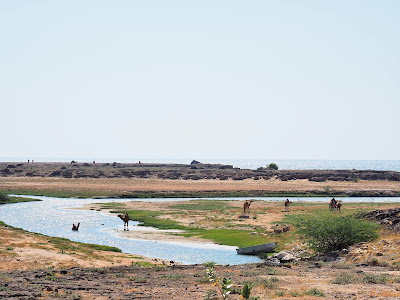Salalah in winter - the frankincense heritage
If you visit a local souq or local family, chances are big that you also smell the burning frankincense. It has a pleasant smell - but as it is typically the case with any ancient tradition, there is a practical reason behind burning it. It has antibacterial effect and it helps on people with breathing problems. Besides burning it, they chew it, drink the water made by soaking the resins and the essential oil is one of the most valuable oils. Since arguably Dhofar produces the best quality of incense, no wonder this region has a long history! Frankincense has been traded on the Arabian Peninsula for more than 6,000 years making the region an important trading center. The importance of this heritage also has been recognized by granting UNESCO World Heritage status in 2020 for four sites under the umbrella of the The Land of Frankincense title. These four sites are :
- the port of Khor Rori - 45min far from Salalah
- The lost city of Ubar - 2.3 hours drive from Salalah
- Wadi Dawkah - 45 min drive from Salalah
- the port of Al Baleed - in Salalah (we did not visit this time)
Khor Rori is a river mouth lagoon close to Salalah where the ruins of the ancient city of Sumhuram can be found. The fortified city was founded at the end of 1st century BC to control trade and production of the incense. Not much left of the ancient city, but clearly they choose a scenic spot - the views are beautiful!
The lost city of Ubar - a very romantic name! The site is over 2.5hour drive from Salalah, within the village of Shisr which is basically the last settlement before the unforgiving desert of Rub Al Khali aka the Empty Quarter takes over. The story of the sight is also very romantic: it was a city built on the caravan route and it sunk into a sinkhole eventually. For centuries there were tales about a city swallowed by the sand and TE Lawrence called the the Atlantis of the Sands (can it get more romantic?). There is even a movie titled The Search for the Lost City of Ubar by Ranulph Fiennes! In the 20th century many tried to locate the legendary town and eventually they managed to do so using satellite images which revealed ancient caravan tracks deeply buried under the sand dunes. Some (especially in Saudi Arabia) still debates if this is Ubar and if Ubar was a city at all or not - there is a long and detailed wiki article about the topic.
The site is quite small, Khor Rori and Al Baleed are both bigger. If you are on the mission of ticking off all UNESCO sites, it is a must. If you are visiting the Empty Quarter, do not miss it. But to drive just for this - probably it is not worth it. Interestingly the area around the site is a major agricultural area with mobile irrigation systems - if you look at satellite images of the area you will see loads of round darker spots, which are all irrigated farmlands practically in the middle of the desert!
It does not look like that now, but there must be a water source if they have these signs!
The camels were black and looked very different from the ones we know from other parts of Oman - apparently they are wild ones from Saudi as we were told
Wadi Dawkah is where the oldest frankincense trees can be found. This dry valley has an estimated 5,000 frankincense trees growing, the oldest of which are thought to be more than 200 years old - these trees are still harvested by the local tribes. The production starts in April and it is quite meticulous process: the tree bark is cut (called tapping) and the liquid released forms drops which hardens - this resin is what is collected. The resins than sorted based on size and color manually - you can see in the souq women sitting around and quickly going through big piles of them.
The oldest trees are fenced off, otherwise one can freely wander around the site.
Taqah Castle - this the dark horse (shall we say camel) of the list as it is neither thousands of years old nor a UNESCO world heritage site. It was built in the 19th century, so safe to say it is very young. It was the private resident of a tribal leader Sheikh Ali bin Taman Al Ma’shani. What makes it interesting though is that this Sheikh is the grandfather of Sultan Qaboos - the father of the sultans mother, who is buried in the yard of the castle. The last extension was carried out in the 60's and in 1994 it became a museum. Unfortunately on the account of COVID it was not open but it supposed to have a great display of how people lived in the early 1900s. It even has a prison! Omantripper as usual has a great article with pictures.






























Comments
Post a Comment